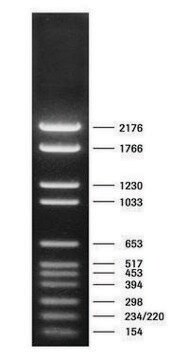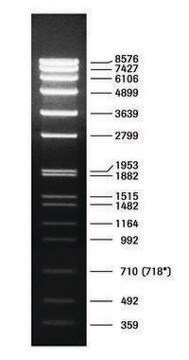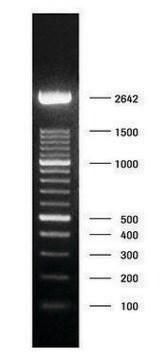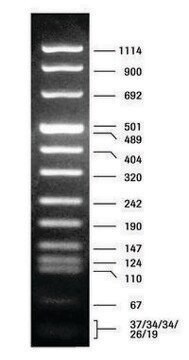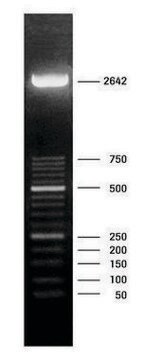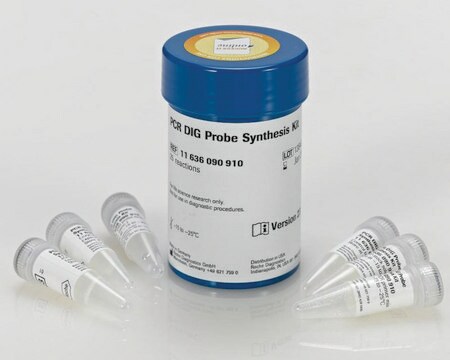11218611910
Roche
DNA Molecular Weight Marker VI, DIG-labeled
solution, pkg of 500 μL (10 μg/ml)
Sinônimo(s):
DNA marker
Faça loginpara ver os preços organizacionais e de contrato
About This Item
Código UNSPSC:
41105335
Produtos recomendados
Formulário
solution
Nível de qualidade
embalagem
pkg of 500 μL (10 μg/ml)
fabricante/nome comercial
Roche
características do produto alternativo mais ecológico
Designing Safer Chemicals
Learn more about the Principles of Green Chemistry.
sustainability
Greener Alternative Product
categoria alternativa mais ecológica
temperatura de armazenamento
−20°C
Descrição geral
DNA Molecular Weight Marker VI, DIG-labeled is a fragment mixture prepared by cleavage of pBR328 DNA and pBR328 DNA with restriction endonucleases Bgl I and Hinf I respectively. The size of the fragment ranges from 0.15 to 2.1 kbp.
We are committed to bringing you Greener Alternative Products, which adhere to one or more of The 12 Principles of Greener Chemistry. This product is designed as a safer chemical. The DIG System was established as a sensitive and cost-effective alternative to using radioactivity for the labeling and detection of nucleic acids. There are many available publications that prove the versatility of the DIG System, so use of radio-labeling is no longer the only option for labeling of DNA for hybridization.
Aplicação
DNA Molecular Weight Marker VI, DIG-labeled, has been used as a size standard in Southern blot analysis for nucleic acid labeling and detection. It has also been used as a size standard for amplified DNA.
Componentes
Ready-to-use solutions in 10mM Tris-HCl, 1mM EDTA, pH 8.0.
Sequência
The mixture contains 12 fragments wit the following base pair lengths: 154/154, 220, 234/234, 298/298, 394, 453, 517, 653, 1033, 1230, 1766, and 2176 bp.
Note: Fragment lengths are derived from computer analysis of the DNA sequence. Depending on the size range of the marker, the smallest fragments will only be visible on overloaded gels.
Note: Fragment lengths are derived from computer analysis of the DNA sequence. Depending on the size range of the marker, the smallest fragments will only be visible on overloaded gels.
Outras notas
12 fragments: 154/154; 220; 234/234; 298/298; 394; 453; 517; 653; 1,033; 1,230; 1,766; 2,176 bp
Fragment lengths are derived from computer analysis of the DNA sequence. Depending on the size range of the marker, the smallest fragments will only be visible on overloaded gels.
Fragment lengths are derived from computer analysis of the DNA sequence. Depending on the size range of the marker, the smallest fragments will only be visible on overloaded gels.
For life science research only. Not for use in diagnostic procedures.
Código de classe de armazenamento
12 - Non Combustible Liquids
Classe de risco de água (WGK)
nwg
Ponto de fulgor (°F)
No data available
Ponto de fulgor (°C)
No data available
Escolha uma das versões mais recentes:
Já possui este produto?
Encontre a documentação dos produtos que você adquiriu recentemente na biblioteca de documentos.
Os clientes também visualizaram
M Agüero et al.
Journal of clinical microbiology, 41(9), 4431-4434 (2003-09-06)
This work provides a novel, highly sensitive, hot start PCR method for rapid and specific detection of African swine fever virus (ASFV) that can be used as a routine diagnostic test for ASFV in surveillance, control, and eradication programs. A
R Ferretti et al.
Applied and environmental microbiology, 67(2), 977-978 (2001-02-07)
A PCR-based method for the detection of Salmonella spp. in food was developed. The method, set up on typical salami from the Italian region of Marche, is sensitive and specific and shows excellent correlation with the conventional method of reference
Stéphanie Tomé et al.
PLoS currents, 6, doi:10-doi:10 (2014-03-13)
Many human diseases are associated with the abnormal expansion of unstable trinucleotide repeat sequences. The mechanisms of trinucleotide repeat size mutation have not been fully dissected, and their understanding must be grounded on the detailed analysis of repeat size distributions
Artigos
Digoxigenin (DIG) labeling methods and kits for DNA and RNA DIG probes, random primed DNA labeling, nick translation labeling, 5’ and 3’ oligonucleotide end-labeling.
Global Trade Item Number
| SKU | GTIN |
|---|---|
| 11218611910 | 4061838699787 |
Nossa equipe de cientistas tem experiência em todas as áreas de pesquisa, incluindo Life Sciences, ciência de materiais, síntese química, cromatografia, química analítica e muitas outras.
Entre em contato com a assistência técnica
